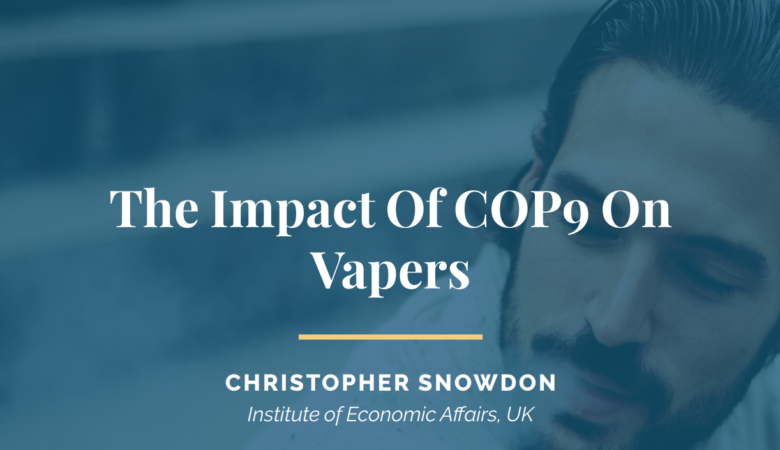The Attack on Reduced Harm Products by the WHO’s Conference of Parties Hurts Public Health
Policies driven by ideology, not evidence have infiltrated the World Health Organization (WHO). Public health continues to be threatened as reduced harm alternatives like e-cigarettes (ECs) and vaping are more heavily regulated and disproportionally targeted for prohibition compared to combustible tobacco products.
The recent release of Christopher Snowdon’s white paper, “The Impact Of COP9 On Vapers” brings to light the contradictions and ideological agenda of the WHO against effective and safe reduced-harm products.
The WHO’s Conference of Parties (COP) is supposed to promote tobacco control policies that adhere to the Framework Convention of Tobacco Control (FCTC). However, the COP ignores comprehensive evidence that supports ECs and vaping are “95 percent safer” than cigarettes. It also disregards that ECs do not encourage tobacco use.
There is a widespread consensus supporting the safety and efficacy of ECs. According to an independent expert view led by the Public Health England (PHE) in 2015 and a report by the Royal College of Physicians in 2016, the risks of vaping are “at least 95 percent lower than the risks of smoking.” An updated Cochrane Review of ECs in 2020 notes individuals using nicotine ECs indicated higher quitting rates than nicotine replacement therapy (NRT) and non-nicotine ECs. Furthermore, science is on the side of ECs and vaping.
Policy recommendations to support heavier regulations and prohibit reduced-harm products ignore evidence to directly go against the FCTC’s procedures. The WHO’s FCTC authorizes harm reduction via “tobacco control” in Article 1 (d). Tobacco control is defined as “a range of supply, demand and harm reduction strategies that aim to improve the health of a population by eliminating or reducing their consumption of tobacco products and exposure to tobacco smoke.” However, the WHO contradicts its own rules by refusing to endorse safe and effective harm reduction policies via ECs and vaping.
Snowdon adds valuable insight that “Unfortunately, the WHO has never pursued harm reduction policies in relation to smoking and in recent years has increasingly worked to stamp out e-cigarettes and other reduced risk nicotine products. This is a bone of contention at the COP meetings because there is no agreement between member states on how to regulate e-cigarettes and other reduced-risk nicotine products.”
In the UK, for example, a Value Added Tax (VAT) rate of 20% was added on ECs that ultimately dissuades the public from seeking alternative products. Without ECs, the decline in the UK’s smoking rate will continue to be slow and gradual. The UK’s Office for National Statistics (ONS) notes the average annual decline in smoking rate was 0.76 percentage points from 2011 to 2019. If ECs and vaping are more heavily regulated, it is highly unlikely the UK will achieve a Smoke-Free Britain by 2030.
In France, the introduction of plain packaging (PP) or the removal of branding (colors, imagery, corporate logos, and trademarks) on cigarettes hurt smoking cessation efforts. As a result of this policy, the French Customs Office reported a 4% increase in purchases of cigarettes after PP was introduced in 2017. Further, any extension of plain packaging on ECs and vaping will make it more difficult for innovators of alternative products to communicate quit-aids are of trusted quality and reputation to consumers and likely harm smoking cessation efforts.
The mission of the FCTC is “to reduce continually and substantially the prevalence of tobacco use and exposure to tobacco smoke” but the WHO’s COP meetings relentlessly assault alternative products. Individuals seeking smoking cessation will be harmed as a result.
This action is particularly concerning given the FCTC in 2016 originally acknowledged “it is very likely that ENDS/ENNDS are less toxic than cigarette smoke.”
Snowdon makes the point that “Although the 2016 document acknowledged that e-cigarettes and cigarettes were substitutes, with higher taxes on the former leading to greater sales of the latter, the WHO did not discourage member states from banning them, and it encouraged those who had not banned their sale to ban or restrict e-cigarette advertising, tax e-cigarettes (. . .).”
The power of the WHO to influence global health with a politically driven policy that affects millions of lives is concerning. It is, even more alarming, the WHO’s COP meetings are done behind closed doors. Vapers, journalists, the scientific community, and the public are not allowed entry or to provide consultation.
Snowdon notes, “In 2014, Drew Johnson of the Washington Times was forcibly ejected from the venue in Moscow after being told that ‘the media is banned.’ In 2018, the internet livestream was cut off early in proceedings.”
Policies go unchecked when transparency and accountability are nonexistent. It should generate concern that meetings which drastically affect millions of lives are secretive.
With the ninth Conference of Parties approaching in November of 2021, governments and the WHO should voice policy recommendations based on evidence, not ideology, and committed to the principles of a democratic society. This meeting is one of the last chances to reverse the damage done to public health.
However, if policies are still driven by ideology, governments should consider withdrawing funding from the FCTC Secretariat as Snowdon concludes.
This white paper will be presented on June 24, 2021, from 18:00 – 19:00 BST at a webinar by the UK’s Institute of Economic Affairs. For more information click here.

